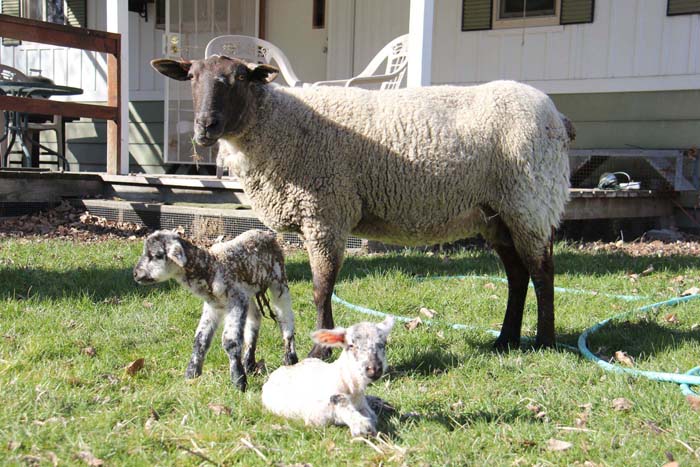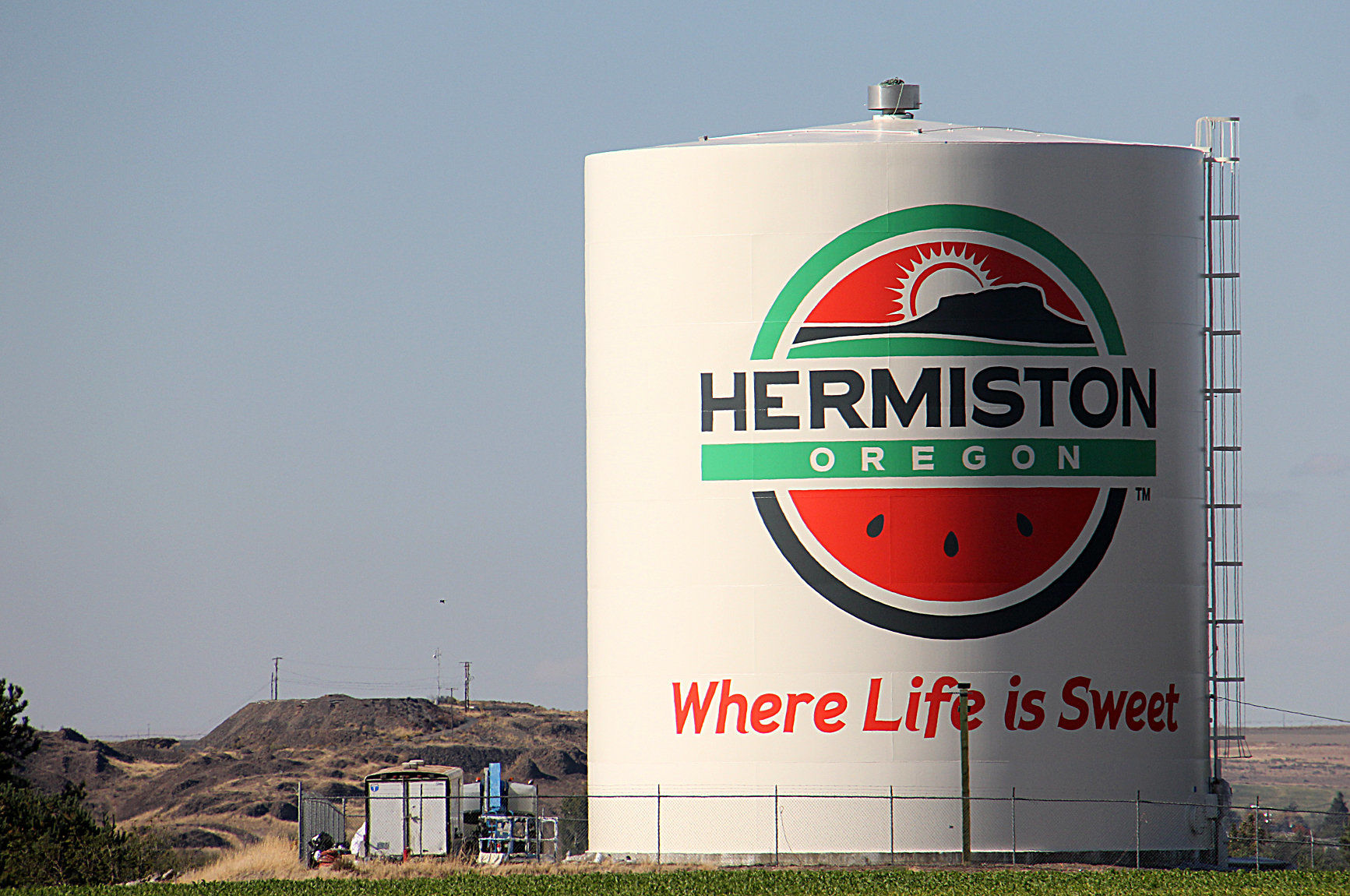Silverdale Farms cross-breeds hardy sheep variety in Hermiston
Published 5:23 pm Monday, March 23, 2015

- Two lambs about two hours old stay close to their mother at Silverdale Farms in Hermiston.
A local couple have years of experience in the sheep industry and continue to breed a flock in Hermiston as the industry continues to change.
Tom and Karin Watson, who have owned Silverdale Farms in Hermiston for about 20 years, have worked with sheep for decades.
Tom Watson worked for Superior Farms, purchasing and feeding lambs before they were sent to slaughter, for about 40 years. He served on the board of directors for several years before he retired, and, although the Hermiston operation was sold about “half a dozen years ago,” he said the company is still the largest lamb processor in the United States with a large facility in California.
Karin Watson served as the secretary for the National Lamb Feeders Association for 23 years before retiring in January. She helped organize and promote the NLFA Howard Wyman Sheep Industry Leadership School for 28 years and recently became one of four women to ever receive the association’s Cane of Appreciation for service to the sheep industry.
Even in retirement, they continue to be involved with sheep at the fair and breed a small flock of about 150 ewes each year.
SHEARING THE INDUSTRY
Tom Watson said national policies and trends and international competition have dramatically reduced the size of the national sheep industry in the last 70 years. Ten facilities on the West Coast processed lamb meat when he started in the industry, he said, and only the Superior Farms facility in California remains.
He said about half of the lamb meat consumed in the United States is produced overseas, in places such as Australia and New Zealand, where it is less expensive to produce the meat.
“Just between the dollar exchange, they can get their dressed product here at the same value as ours,” he said. “I think the Australian dollar is somewhere around 80 cents now, and the New Zealand dollar might be a little lower, and that’s a huge advantage for an exporter, not so good for the folks where the product is going.”
Despite the competition, he said the sheep business and the market for lamb, especially last year, has been “good.” He said the number of sheep in the country, however, has declined sharply through the years.
“At the end of World War II, there was 45 million sheep in the United States, and now there’s about 4.5 million,” he said. “That’s what’s happened to the industry. Most of it’s labor and availability of range to run them on.”
Karin Watson said it is difficult to find quality employees to tend the flock while grazing.
“It’s a 24/7 job,” she said. “You can’t leave them. We used electric fence, which is a big help, so they don’t have to be totally herded, but you still have to have a human being there to make sure they’re going to be safe, so it’s a challenge.”
Sheep operations in the Midwest and eastern United States often keep their animals inside of fenced property, she said, but, on the western side of the country, most operations rely on federal land for grazing.
“Sheep producers have been dependent on the (Bureau of Land Management) and Forest Service for their summer grazing, and that’s been severely restricted, and it’s not getting better,” she said. “There’s all sorts of conflicts with predators, a.k.a. the wolf, and then we’ve got the cougar and all the other large predators that are in the hills. It’s just made it difficult. … You can’t afford to put them in a confined feeding situation. It’s astronomical to keep mother ewes. It’s like putting cows in a feedlot to wait for them to calve next year. It just doesn’t work.”
Karin Watson said she knows people in the Northwest who have been forced to discontinue grazing their sheep on land their family has used for generations because of new policies.
“They’re running big numbers, and where are they going to take them?” she said. “It’s a challenge.”
Tom Watson said the most difficult challenge current sheep operations face is government policy.
“There’s issues of wolves,” he said. “There’s issues of supporting the folks who work in the trapping side of the U.S. government. There’s issues of the spotted owl. All of these issues have shrunk the availability of range for both cattle and sheep, so it’s a big, big factor. … There’s a lot of factors. Farming’s changed. A lot of the country that was grazed by sheep 50 years ago is now in irrigation, similar to what’s around here in Hermiston and the Columbia Basin, and all that ground was pastured at one time. You find similar situations in other parts of the country. It’s a changing industry, like all industries are. Change with the times.”
SPECIALIZING WITH SILVERDALE
Karin Watson said the couple’s daughters were involved with 4-H and FFA and showed sheep at the fair, so they “had a few around all the time.” The family’s flock of black-faced Suffolk sheep, which are common at fairs, grew through the years, she said, but, about 20 years ago, the Watsons started breeding the Suffolks to white-faced Texel sheep to create a cross-breed they call Silverdale for its speckled, silver face.
“The Suffolk has been developed into a pretty large sheep and pretty streamlined-looking for the show ring,” she said. “The meat qualities, we feel, have been secondary, so we were looking for more muscle, more meat, which, in the layman’s term, creates more yield.”
Texels, she said, are “shorter-statured, wider-bodied, bigger-muscled” sheep that originated in Holland and, when bred with Suffolks, produce the desired qualities.
“You have one animal that’s a slender-built animal and one that’s real meaty,” she said. “This is going to give you more meat. It’s just natural.”
Karin Watson said Silverdale Farms’ primary operation is selling its best Silverdale rams to commercial flock owners for breeding. She said the cross-bred Silverdale is also a stronger stud animal with “hybrid vigor.”
“The Suffolks have been bred over the years, and they aren’t noted for longevity,” she said. “Our goal is to raise a ram that can go out with a commercial flock of ewes and go through breeding time and then come home and rest up and be ready to go next year. Some Suffolks have a reputation of not being that successful. We were looking for a cross-breed that would have the hybrid vigor and also create more meat in the offspring. It’s what you call a terminal sire. All of our rams’ lambs in a commercial flock go to the meat market. They’re not kept for breeding.”
Karin Watson said Silverdale Farms maintains about 150 ewes for annual breeding: about 30 pure-bred Suffolks and a slightly larger group of pure-bred Texels, but the majority are Silverdales. The goal is for each ewe to produce two lambs each year, she said, but the 150 usually produce between 225 and 250 each year around March.
“We want twins,” she said. “All of our females are twins or triplets themselves. We don’t keep any singles, so, if she just has one lamb, that lamb goes to market. If she singles twice, she’s going right along with the lamb because it costs the same to feed a ewe that gives you one lamb versus one that gives you two, and they can easily raise two.”
She said, while it is not uncommon for a ewe to have a single lamb its first breeding year, if that continues, it might be a genetic predisposition, which could be passed onto the offspring. If a ewe has triplets, she said she will remove one of the lambs from its mother and feed it with a bottle or try to pair it with another suitable ewe because the ewes only have two teats.
The Watsons use a variety of criteria to select the best Silverdale rams from the offspring to sell for breeding.
“We sell about 70 rams for breeding a year,” Karin Watson said. “That’s the top of the top. We grow them fast. By Sept. 1, they’ll weigh an average of 180 pounds each. They’re fast-growing, and they can be sold for breeding, but before we allow them to be sold for breeding, we ultrasound the rib-eye and see what size the lamb chop is, and they’re ranked. If they don’t fit our criteria there, they go to market, and they’re not for sale. We want to tell our buyers what they’re buying from us is something we’d keep ourselves for breeding.”
She said some of the best remaining lambs are kept for future breeding at Silverdale Farms, but most are sent to the Superior Farms processing facility in California, usually by the first of September.
The Watsons shear the Silverdale Farms flock in September, Karin Watson said, and the “five months minus five days” gestation period begins again with a new round of breeding in October.





